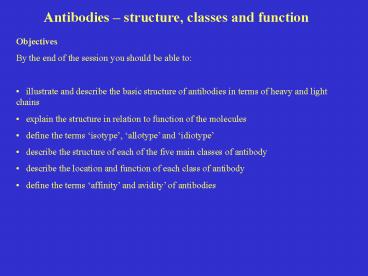Antibodies structure, classes and function - PowerPoint PPT Presentation
1 / 29
Title:
Antibodies structure, classes and function
Description:
define the terms isotype', allotype' and idiotype' ... and toxins; only class of antibody to cross the placenta to provide the newborn with protection ... – PowerPoint PPT presentation
Number of Views:5647
Avg rating:3.0/5.0
Title: Antibodies structure, classes and function
1
Antibodies structure, classes and function
- Objectives
- By the end of the session you should be able to
- illustrate and describe the basic structure of
antibodies in terms of heavy and light chains - explain the structure in relation to function
of the molecules - define the terms isotype, allotype and
idiotype - describe the structure of each of the five
main classes of antibody - describe the location and function of each
class of antibody - define the terms affinity and avidity of
antibodies
2
Basic structure of antibodies
3
Primary antibody structure
4
IgG
5
Antibody structure
6
(No Transcript)
7
Binding of lysozyme to V domains of heavy and
light chains
Heavy Chain
Lysozyme (antigen)
Light chain
8
Antibody heterogeneity Isotypes Two light chain
isotypes k and l Five heavy chain isotypes
- m,g,d,a and e Allotypes Genetic markers-
(rather like blood groups and usually the result
of minor amino acid differences) on
immunoglobulins that segregated within the
species and inherited in Mendelian fashion eg. Km
(on k light chains) and Gm (on IgG heavy chains)
Idiotypes Each antibody varies in its amino
acid sequences in the variable regions of both
heavy and light chains to create different
specificities
9
(No Transcript)
10
(No Transcript)
11
- Different classes of antibody have
- Different distribution within the body
- Different primary functions (but with some
overlaps) - ie. There is division of labour within the
antibody system
12
Ig class Heavy chain Light chain IgM m
(mu) k (kappa) or l (lambda) IgG g (gamma) k
(kappa) or l (lambda) IgA a (alpha) k (kappa)
or l (lambda) IgE e (epsilon) k (kappa) or l
(lambda) IgD d (delta) k (kappa) or l (lambda)
13
IgM
Large molecule, pentameric structure mainly
confined to the circulation prominent in early
responses to most antigens provides first line
of defence against bacteraemia
14
(No Transcript)
15
Antibodies - electron micrographs
IgM (pentameric)
IgA (dimeric)
16
IgG
Predominant antibody in internal body fluids,
including extravascular sites where it combats
microbes and toxins only class of antibody to
cross the placenta to provide the newborn with
protection
17
(No Transcript)
18
IgA
Provides the primary defence against local
infections owing to its abundance in saliva,
tears, bronchial secretions, nasal mucosa,
prostatic fluid, vaginal secretions and mucous
secretions in the small intestine
19
(No Transcript)
20
IgE
Provides protection at mucosal surfaces where it
enhances acute inflammation through mast cells
and recruits anti-microbial agents is raised in
parasitic infections is responsible for the
symptoms of allergies
21
(No Transcript)
22
IgD
Mostly present on the surface of B lymphocytes
with monovalent IgM where it acts as an antigen
receptor controlling lymphocyte activation and
suppression
23
(No Transcript)
24
Summary of different classes and subclasses of
antibodies
25
Antigenic determinants (epitopes) recognised by
antibodies
26
Physical forces holding antibodies and antigen
together
27
(No Transcript)
28
Affinity and avidity of antibodies
Affinity The tightness with which the antigen
binding site attaches to an antigen determinant
(epitope) Avidity The tightness of binding when
several antigen binding sites attach to several
antigenic determinants
29
Antigen-antibody complexes (immune complexes)

